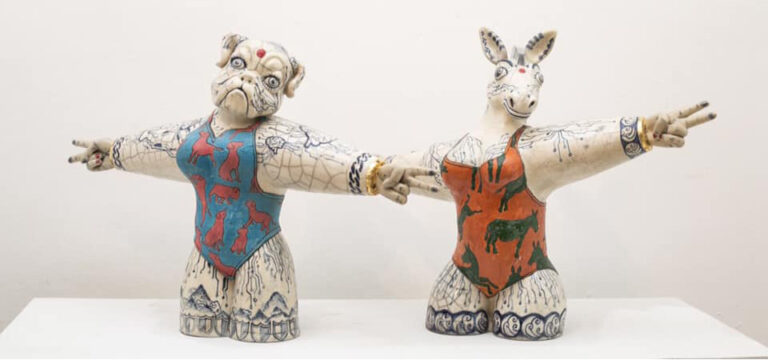
“Women are inherently more powerful than men and extreme feminism is not necessary to prove the intrinsic vigour of females,” says master ceramic artiste Gopal Kalapremi Shrestha, who is interpreting the natural power of women through ceramic art, currently in the exhibition at Siddhartha Art Gallery, Babar Mahal, Revisited.
During the chaos unleashed by COVID-19-induced lockdown, he became engrossed in making ceramic creations to portray the black and white life caused by the pandemic and the fundamental energy of women through exhibition titled “Where the Wild Things Are”.
The astounding ceramic art creations displayed at the gallery interpret the series of arts especially representing the inherent power of women and grim state of human psychology and uncertainty of life.
In his ‘Cows that want to be bulls series’, he has meticulously made cows whose hump is developed, symbolically indicating today’s women who want to become men by forgetting their inner potential.
What’s more, he has expressed real women power through the series “Gau Gau Baat Utha” in which he celebrates the achievements made by Nepali women in all walks of life. He has celebrated a Nepali revolutionary song sung by musical duo Ramesh and Ryan through his art and trying to explain women from all corners of society that they should be empowered.
Similarly, in the ‘Jenny’ or ‘Gadaini’(donkey) series, there are 12 donkeys representing 12 zodiac signs. One by one, women can be seen in different positions on all the 12 donkeys. According to him, those donkeys are the image of the daughters-in-law, and those who are ‘controlling’ them are the image of the mothers-in-law.
Through these arts, he has tried to show that women are not oppressed from males but from women themselves.
He said that there is a misconception in Nepali society that men suppress women. “Men cannot oppress women.
It is women who are oppressing women in our society.” Likewise, he has portrayed a set of six large ceramic torso like vessels, titled ‘Vessels Have Stories’ which depict trauma and accolade the black and white brings into life.
A smaller series of 11 ceramic paintings titled ‘The Flight of the Crows’ depict the arduous life of the crow as it navigates urban spaces – while some crows soar in the sky, some meet a harrowing end, entangled in barbed wire and electric cables. Along with Kalapremi, the ceramic creations made by his wife Yamuna Shrestha and his son Shushank Kalapremi Shrestha are also on display at the art gallery.
Yamuna Shrestha, who is known for her origami creations, has impeccably made ceramic creations like bowls, plates, and cups.
Their son Shushank Shrestha, a BFA graduate in Fine Art from the Kathmandu University, is also exhibiting alongside his parents with a series of beguiling and playful art works like birds, beasts, flora and fauna, shoes and so on.
Master ceramic artiste Kalapremi has been devoting on ceramic art over three-and-a-half decades. According to the gallery director Sangeeta Thapa, Kalapremi is the legendary ceramic artiste who have immensely contributed to promoting Nepali art.
Kalapremi said that ceramic artists make their own colors as they are not available in the market and so artiste has his own identity in the colors used in the ceramic creations.
Pottery has been established in Nepal as a form of ceramic art, and many new generations have been born to work in it. He has tried to combine the multidimensional aspects of life and the universe in modern sculpture in ceramic art.
His role is important in expanding such art in Nepal. In Baluwatar, he had set up an ‘Amateur Studio’ a decade and a half ago to create ceramic art where his family, along with other art scholars, work on ceramic art.
At present, artiste Kalapremi is busy designing the zen garden and open air sculpture museum for the Unnati Village Development Project under Chaudhary Foundation in Nawalparasi, Chitwan.
The ceramic art exhibition of the family, which started on August 4, will continue till September 3.
Source : TRN,





